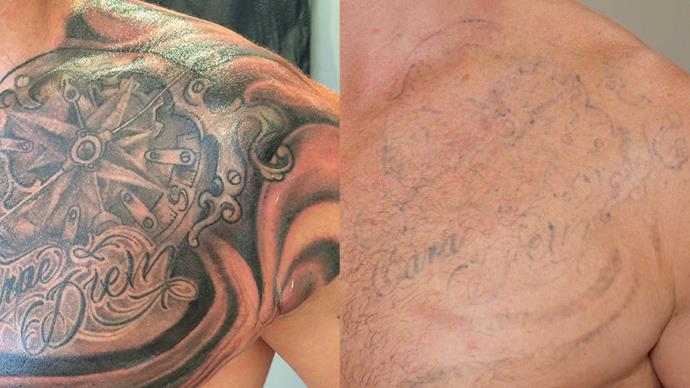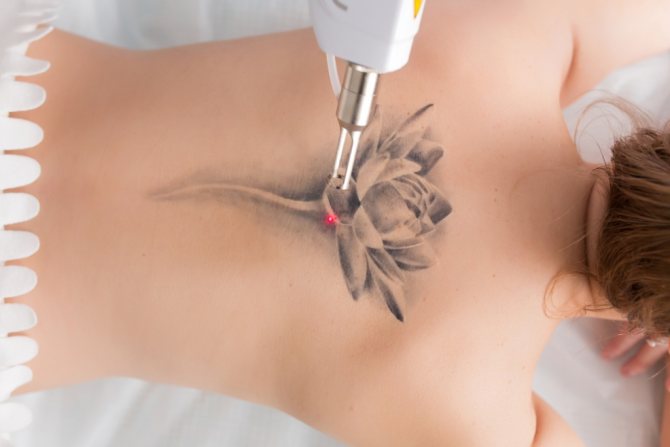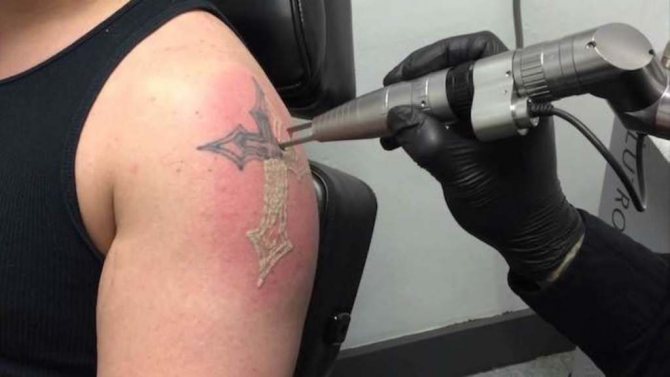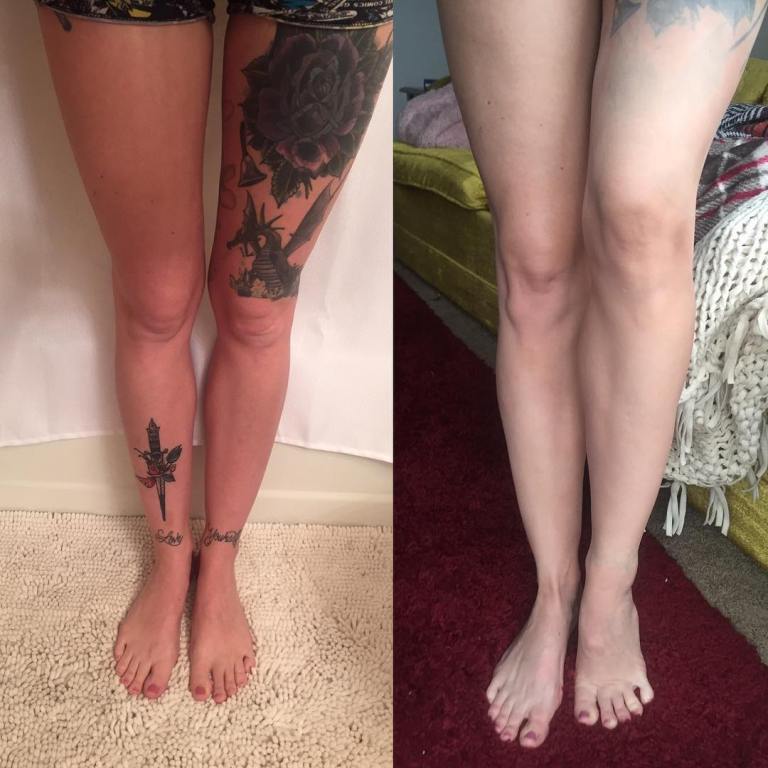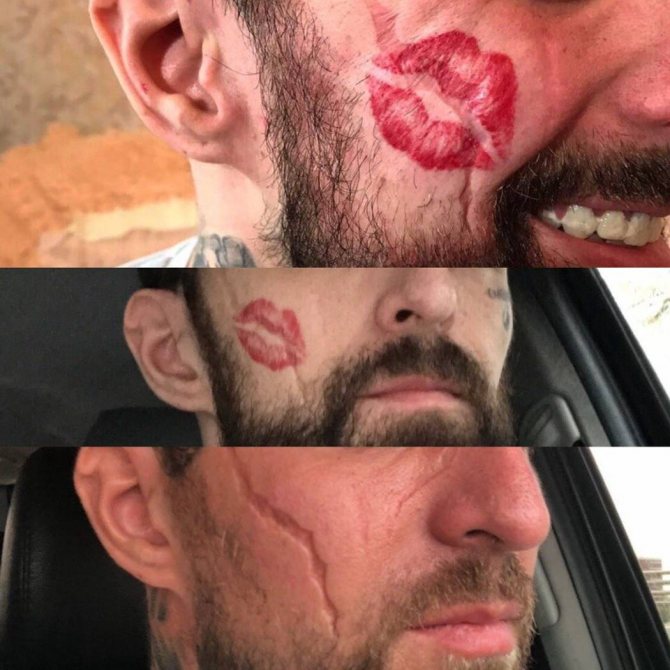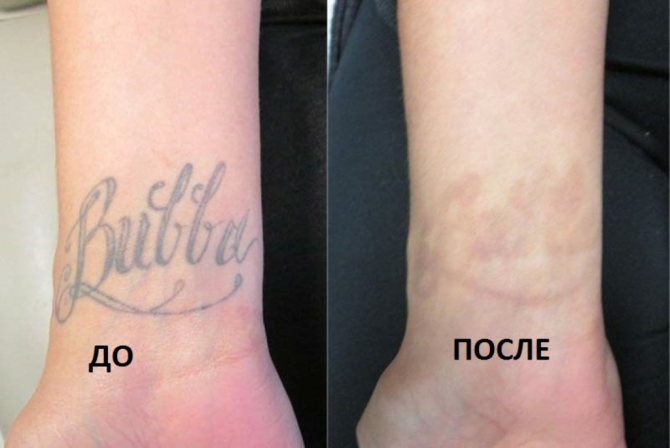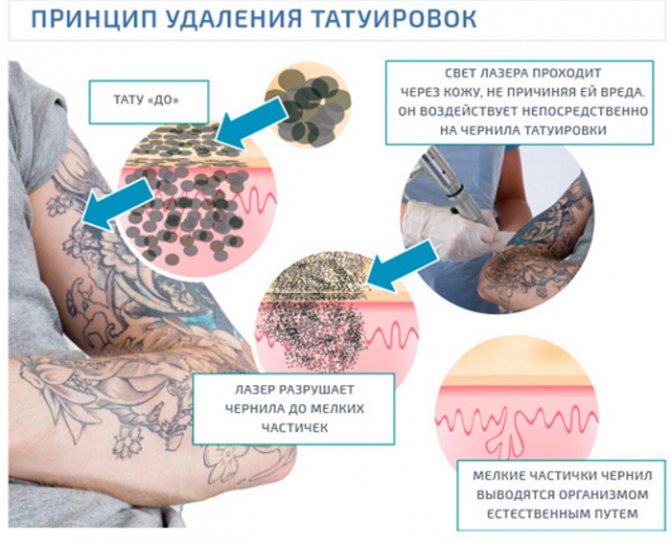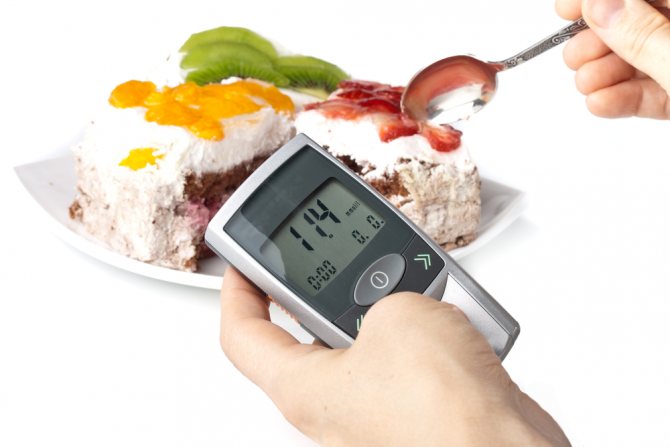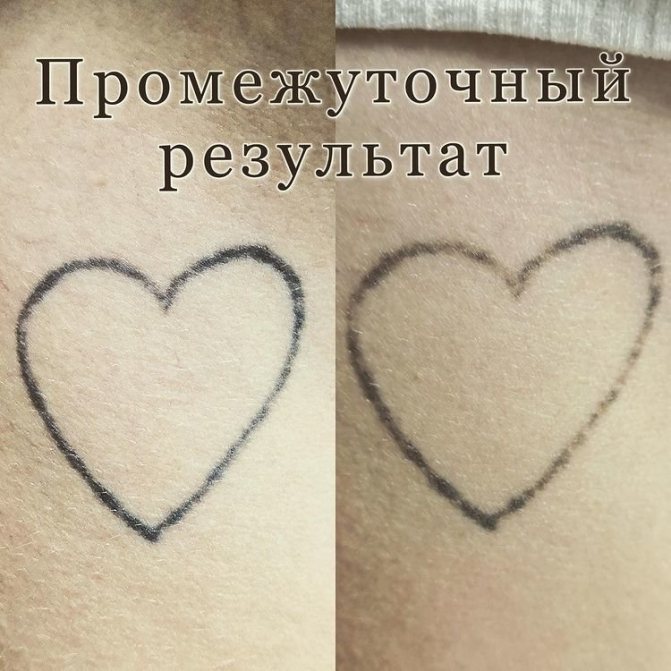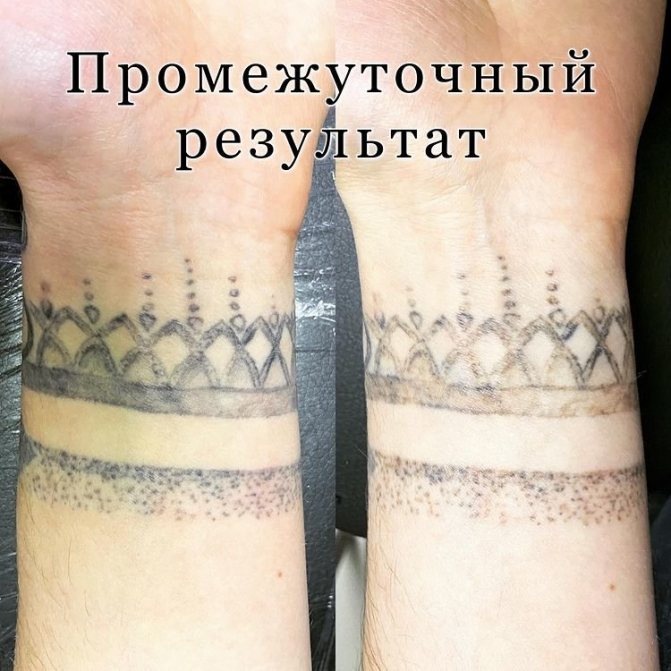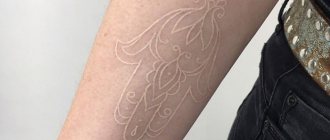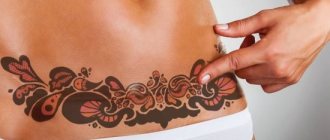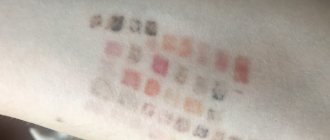- 162
- 0
Tattoos on the body of men and women have not surprised anyone for a long time. Today it is part of the image, the possibility of self-expression, the decision to imprint something important on the body. Despite the fact that it is recommended to choose a tattoo responsibly, many people decide to apply a pattern spontaneously, which then regret. Fortunately the opportunity to remove the tattoo completely exists for a long time.
We tell what means and ways, allowing to remove a tattoo, apply modern masters.
History and development of the method
The laser is a beam of light, which is amplified by induced radiation. The beginning of the use of this technology in the field of tattoo removal was in the 60s of the twentieth century, when it was proposed for this purpose by physicist Theodore Maiman from the United States. Until 1965 the ruby laser was used. Developments such as yttrium-aluminum garnet (neodymium), argon, and later carbon dioxide lasers were also derived. Unfortunately, this method was not devoid of disadvantages: more often than not, scars and scars were left in the place of removal.
Note! Over the years, techniques have been improved, and today they are widely used in cosmetic practice.
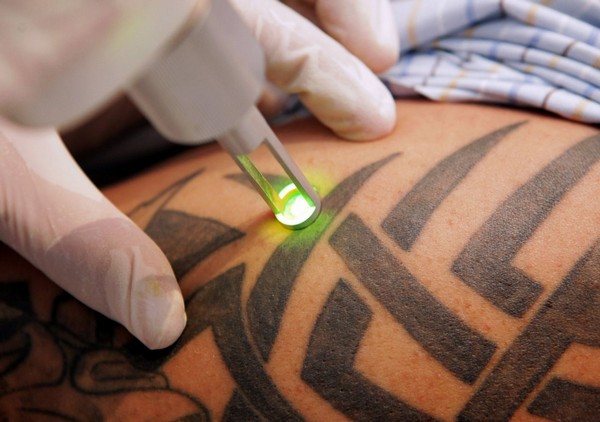
Today this method is widely used.
The next significant step in the development of laser technology was made in 1983, when the theory of selective photothermolysis, or SPT. It was a breakthrough - scientists and doctors were able to understand exactly how the laser affects the skin, were designed the first laser installations for use in cosmetology.
Mechanical tattoo removal
Mechanical removal is the cutting out of the tattoo along with the skin. Such methods include excision, skin grafting, and resurfacing. It is worth noting that after the procedure scars on the body in any case will remain. The healing process will also be painful. A tattoo on the arm, of course, will hurt less. But the operation on the sensitive parts of the body (for example, on the neck) will cause great discomfort. Despite the apparent advances in the field of cosmetology, mechanical intervention in the human body is quite questionable and ineffective way to remove the tattoo. Let us consider in detail the principle of each of the procedures.
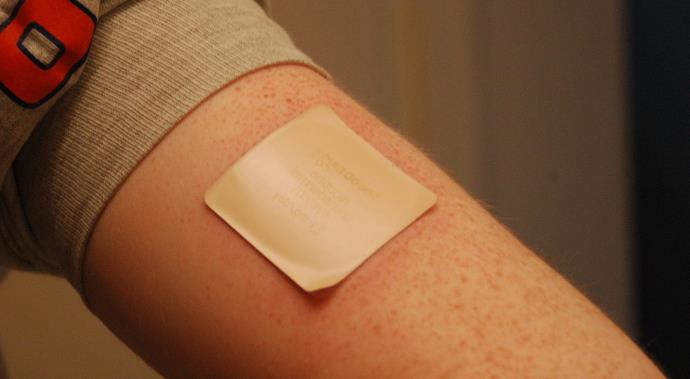

- Grinding is performed with a drill or cutter, which slices the skin layer by layer. The operation is done under anesthesia, but the result leaves much to be desired: scars and scars after healing are very visible.
- Skin grafting can be performed using two methods: take a section of the required size from the back or buttocks or artificially augment the skin. The first option is cheaper, but in 30 per cent of cases, skin rejection occurs. The second option is more effective than the previous one, but it takes more than three months. In addition, the cost of a renewed square centimeter of skin is $150. The surgeries in both cases take place under local anesthesia, and they last about 5 hours.
- The excision involves cutting out the design. If the tattoo is larger than 1 by 7 cm, the removal is done in parts. A small section is cut off, and the edges on the sides are stitched. As a result, a continuous scar is formed in place of the design.
Any of the above methods will not allow you to remove the tattoo without a trace, and being under anesthesia increases many times the likelihood of a stroke.
The use of laser technology nowadays
In cosmetology, the effect of the laser is divided into two types.
- Ablative effect. In this case there is a kind of "erasure" of the upper layer of the epidermis, which is applied to the unwanted pattern. In order to understand the technology, we can consider the example of a carbon laser: a directed beam of light heats the water in the tissue, and then causes the effect of its evaporation in a short time, simultaneously with the elimination of epithelial particles due to what occurs denaturation of the protein. The tulium and erbium lasers have the same effect - their beams are absorbed by liquid structures many times stronger.

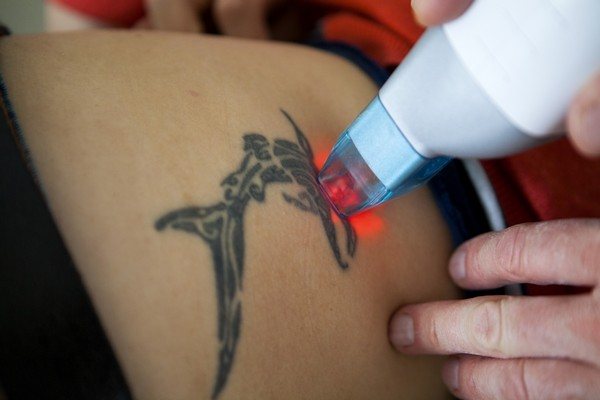
Ablative effects - Selective laser action: lesions inside or under the skin are treated. The skin itself is not damaged. To perform the procedure in this way, a special laser with specific parameters of wavelength and mode of exposure is required. The laser light is absorbed by the dyed tissues, the destruction and discoloration occur due to the photothermolytic effect. The uncolored tissue remains intact. Wavelengths are selected of a specific wavelength for each dye color used in tattooing. After the procedure, laser damaged cells and dyes that have undergone decay are eliminated on their own by the lymphatic system and exfoliation of skin particles in about a month.


Selective laser action
In general, for the complete removal of the tattoo requires several procedures, the total period from a month to a year - the duration depends on the depth of the ink and the amount of work.
Pay attention! Usually there is no trace on the skin during the second type of exposure - the wave impulse is too small to cause severe damage to the skin.
Indications for tattoo removal from the body
It is easiest to remove a tattoo that has been applied to light skin. In places with the least amount of fat, such as on the fingers and toes, it is much more difficult to remove the figure, so in this case you should not hope for an absolutely perfect cleansing result. As for the appearance of painful sensations, they depend entirely on how each individual person endures the pain.
It is also worth noting that drawings that were applied to the skin several decades ago are much easier and faster to remove. This is due to the high resistance of modern ink used to apply the image today. In addition, the complexity and size of the drawing is significantly different in recent times.
In some cases, laser tattoo removal requires taking medications with anesthetic effects. Ointments with anesthetic properties are most often used for this purpose. If you have a low pain threshold, you may need a local injection of a special drug.
How does the procedure go?
The essence of tattooing is that the pigment (ink, dye) is not applied to the surface, and directly into the cells of the skin, resulting in an accumulation of microscopic drops of dye.
Pay attention! In the past, tattoos were removed by very traumatic methods, such as surgical excision of the skin, scraping - all of which led to the formation of large ugly scars. In the middle of the twentieth century, lasers began to be used, and the technology improved, until by the 1990s it had become the most popular in the field.
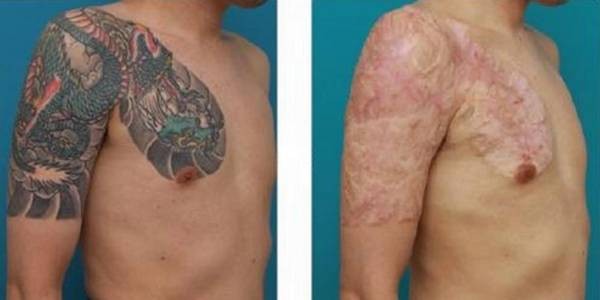

In the past, tattoos were removed by excising the skin
Factors that affect the outcome of the work.
- Characteristics of a tattoo. These can include the composition of the pigment, the size and location of the figure, the depth of the ink, the tool used for the application and the condition of the skin (the presence of scars).
- Skin type. The pigmentation itself is important - whether the skin is dark or light, the state of health of the dermis. All this is important for the proper selection of the laser machine.
- Laser characteristics. The details of the laser, such as wavelength and duration of the incoming pulse, are taken into account. In order to eliminate all particles of pigment and not to cause traumatic effects on the skin, it is necessary to direct the laser energy of the appropriate wavelength - it is not always easy, some shades are quite problematic to remove, and the easiest way to work with black pigment.


The efficiency of removal depends on several factors
The QS (Q Switch) laser is generally accepted as the standard for laser removal of skin marks. It has the ability to select the desired wavelength, taking into account the color of the skin and the pigments used, as well as the appropriate duration of the pulse. Usually to get rid of a tattoo with such a laser it is necessary to have several sessions, each of which is carried out once a month.
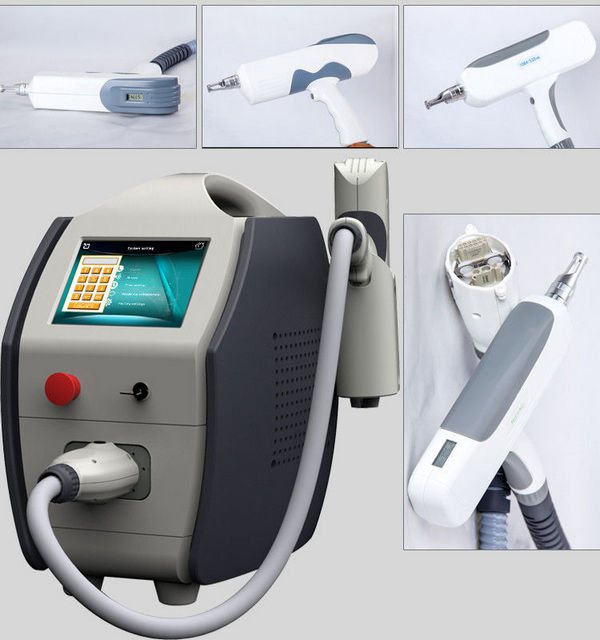

Q Switch Laser
Factors influencing the success of a tattoo removal
Factors that most strongly influence the speed of tattoo removal are presented in the table below
| Factor | Difficulty of getting rid of the tattoo |
| Age of design | The older the tattoo, the harder it is to get rid of. |
| Color of a person's skin | The lighter a person's skin color, the easier it is to get rid of an obnoxious design. |
| Tattoo location | The easiest to remove tattoos are considered legs, arms, chest and buttocks. |
| Color of ink used | The hardest tattoos to remove are those made with colored ink. And it is easier to remove monochrome tattoos, which are made in black, blue and red colors. |
| The speed of cell regeneration in a particular person | The faster the cells regenerate, the faster it is possible to remove the tattoo. |
Based on the above, it is most difficult to remove a tattoo that was done long ago to a dark-skinned person in colored ink.
The best way to remove a recently inked tattoo is with a laser. It may only take 1 session for the design to become virtually indistinguishable. Sometimes the procedure needs to be repeated. The experienced master of the tattoo salon will not only choose the best removal technique, but also recommend the most progressive equipment.
Contraindications for the procedure
A general list of conditions in which tattoo removal is contraindicated:
- Any diseases of the cardiovascular system;
- mental pathology;
- Skin diseases, dermatitis, eczema, etc;
- Pregnancy and breastfeeding;
- Individual intolerance.
In order to perform a tattoo reduction, you will need quite a lot of time and several sessions with a beautician. It usually takes about 7-8 treatments per medium-sized drawing (each one is done about once a month).
The process will be long and very painstaking, requiring enough patience and funds to see it through. Thus it is recommended to address in advance to the highly skilled experts who work on the modern equipment in order to avoid subsequently serious problems.
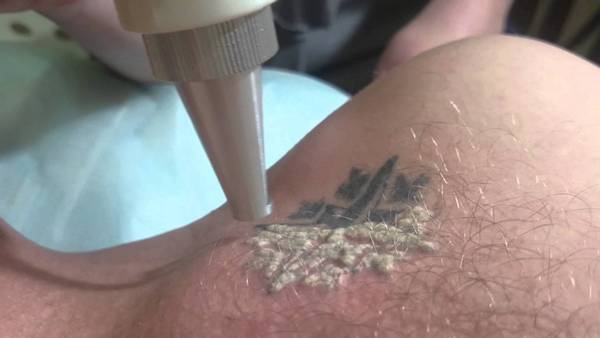

Removal of tattoos with a laser - the process is not quick
During the procedure, you may notice a faded pattern, but at first it is only a temporary effect, which soon disappears. After the first sessions the color saturation will gradually return - you should be prepared for that.
Pay attention! The process of pattern removal can be quite painful - in order to avoid this and make the procedure more comfortable, local anesthesia and light sedatives are used.
Also commonly used is a cooling unit with the effect of chilled air - this method of reducing pain sensations began to be used relatively recently, and has already received the first positive reviews. Ice compresses and topical creams with the effect of anesthesia can also be used. In some cases, injections of anesthetic medication (such as lidocaine) directly into the treated area are used. In addition, modern laser equipment allows for manipulation with greater comfort.
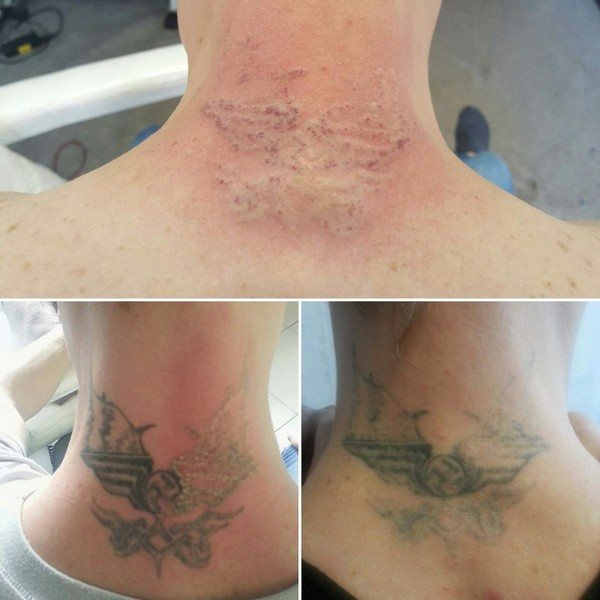

The skin is anesthetized so that the patient does not feel discomfort
Selecting a specialist and clinic
Before you go to the clinic for tattoo removal, you will need to find out if the specialists working there have a license to perform these manipulations, read the reviews of other clients. Availability of doctor's portfolio with pictures before and after tattoo removal will be a plus. The main list of questions to ask at the consultation.
- What equipment is used during the session (better if the latest generation laser is used, which, unfortunately, not all clinics can afford).
- Anesthesia methods used.
- What are the guarantees of safety during the procedure: the doctor and the patient must have protective glasses, a separate room is allocated for the laser, and the beautician must have a special permit to work with this type of equipment.
- Ask for a list of possible side effects from the procedure, as well as warranties provided.


It's important to learn all about the procedure
Please note! The specialists at a trustworthy clinic should have no difficulty answering these questions, and the lack of adequate comments can be alarming.
Other methods of tattoo removal
There are also other methods of removing drawings without using laser technology.
- Skin resurfacing: in order to perform this procedure, it will be necessary to scrape off the top layer of skin with a special device with a diamond coating. It is quite a dangerous procedure, as there is a high risk of infection, you will need to wear a bandage for a long time and treat with antiseptics. It often causes scarring and scars. Usually costs much less than other methods.
- Surgical removal. The most traumatic method of tattoo removal, which consists in cutting out part of the skin with the inflicted design. Here, the appearance of scars is not avoided.
- The use of chemicals. Drawing is removed using bleaching ointments with piercing with a special needle. This is a long procedure, requiring a high level of professionalism of the specialist, not every beautician takes it.
- There is also the possibility of tattoo treatment with liquid nitrogen - the upper layer of epidermis is subjected to necrosis and removed. It is a very painful and time-consuming method, but it is cheap.
- Similarly "works" method of electrocoagulation, in which the tattoo is affected by high-frequency currents. Severe burns and scars can occur.
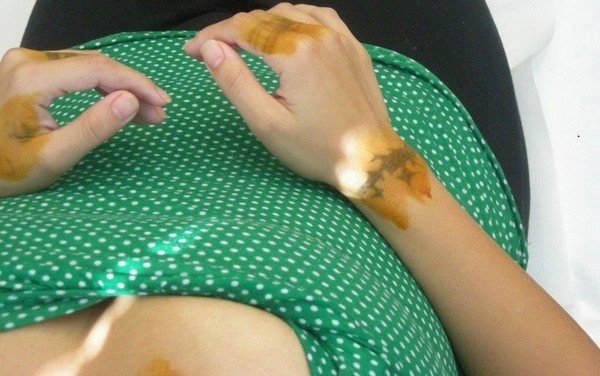

There are other methods of tattoo removal, but they are not considered as effective
In this age of widespread information can easily find reviews of real people who have faced with tattoo removal procedures in one way or another, so it is better to familiarize yourself with them in advance.
Pay attention! Do not skimp on this procedure.
Laser tattoo removal
On the laser tattooing removal now speaks as the most effective method, which appeared in the middle of the twentieth century. The technology is simple enough: the laser beam penetrates through the epidermis layer and splits the pigment into molecules. Laser tattoo removal is a virtually painless procedure that does not cause much discomfort. The picture is lightened within a month and disappears completely, leaving only a white spot on the skin.
The number of types of laser in modern medicine reaches 10. The most popular ones are alexandrite, ruby, neodymium and Q-switch models. For each tattoo a specific type of apparatus is chosen that is most suitable for the particular image size, color saturation, as well as the physiological characteristics of the client.
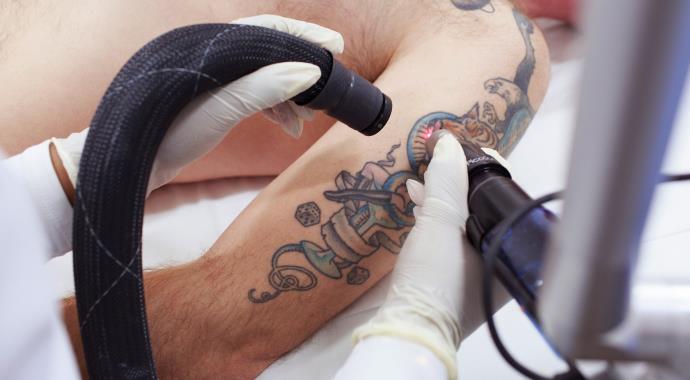

The advantages of laser tattooing are as follows.
- It is possible to remove the design without significant damage to the skin. This is the only effective way to remove a tattoo without a scar.
- The procedure is not accompanied by painful sensations. With a competent choice of laser and the experience of a specialist, the tattoo can be removed painlessly even in sensitive areas (for example, on the neck or wrist).
- It is the most effective and fastest of all modern methods of tattoo removal. The average number of sessions is from 1 to 10, but already after the first visit there are visible results.
Laser removal also has disadvantages.
- This method is characterized by a relatively high price. The cost of the procedure is measured in square centimeters and averages about 1000 rubles for an area of 2 by 2 cm. Depending on the number of sessions, the complexity of the design and the quality of consumables, the price may vary. To get a medium-sized tattoo removed, one has to pay around 20,000 rubles, which is not affordable to everyone.
- The effects of laser radiation on humans are not fully understood. Some physicians are of the opinion that the laser can cause cancer.
- Exposure to the rays sometimes results in an inversion of color. This means that the pigment is not cleaved, but rather darkens. In this case, the tattoo cannot be removed.
- Inexperience of a specialist can lead to burns and scars. Choose a proven and reputable institution.
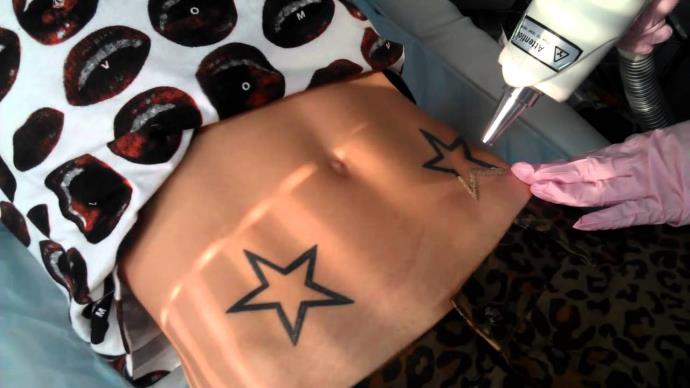

Contraindications and cautions
- Laser tattoo removal is contraindicated for people with diabetes, hepatitis, cancer, and HIV.
- The procedure is not recommended during colds, pregnancy and menstruation in women.
- Before the session, it is advisable to refrain from alcohol.
If you have made the final decision to get rid of an annoying pattern and care about your health, trust the specialists. Laser tattoo removal is not cheap, but the effect surpasses all expectations.
How do they remove tattoos at home?
Not everyone is satisfied with the possibility of salon removal of unwanted tattoos, many people prefer to do the job themselves at home. This practice can not be called safe, given that now available quite a lot of techniques that allow not to resort to such methods.
All of the ways in which you can remove tattoos at home are really dangerous, so the following methods are listed for introductory purposes only. We consider it necessary to warn you that such methods are not only very painful, but often either completely ineffective or leave serious crippling scars and can have devastating health consequences.


It is even possible to remove a tattoo at home, but this is quite dangerous
Manganese dioxide compresses in the picture lead to the formation of sores and burns, which are then difficult to treat. Alkali has the same effect.
The use of iodine - a long, less dangerous, but practically ineffective process, which can drag on for several months.
Celandine juice is a poisonous substance that can cause severe burns and allergic reactions.
The salt causes severe pain, making the procedure almost intolerable.
Even with the best possible outcome of these methods, serious damage, scarring and scars will be left on the skin. In the worst case, you can get burns, poisoning and infection entering the wound, leading to blood poisoning.
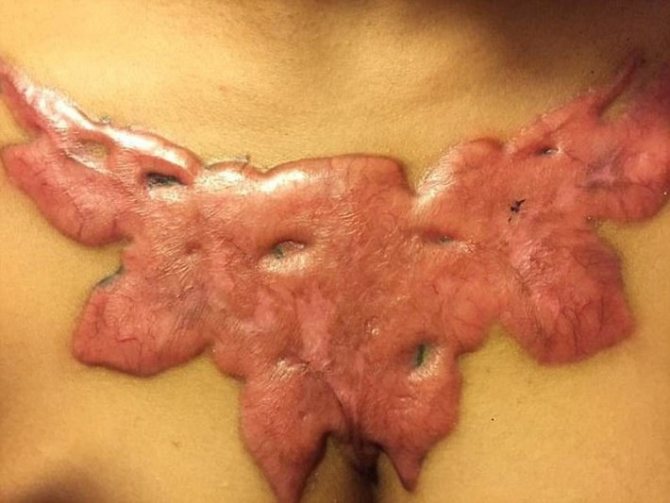

Most likely, after self-tattoo removal, scars will be left on the skin.
Pay attention! Based on this we can conclude that the only effective way that is not harmful to your health is the help of a qualified cosmetologist.
Reasons for tattoo removal
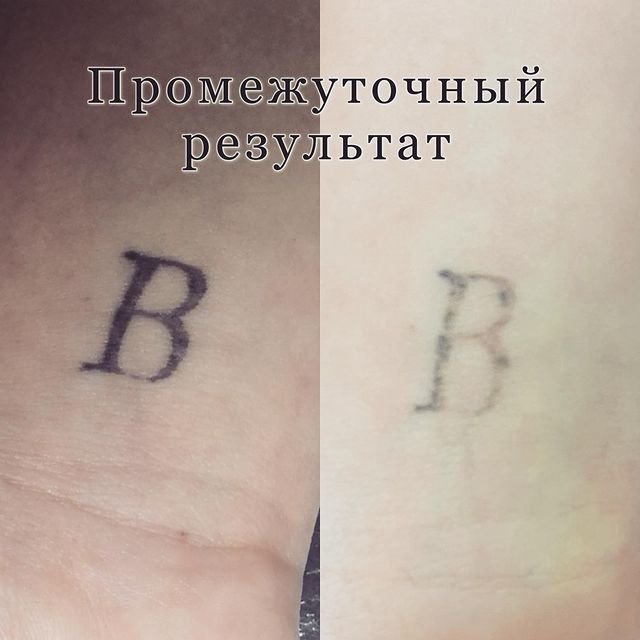

It used to be that, when deciding to get a tattoo, people understood that it was forever, because there were no reliable ways to remove them. Today, many people are quite thoughtless about the choice of a drawing or a master, so after a while they turn to specialists with a request to remove the "masterpiece".
See more...
✅ How to get a tattoo at home: 7 ways
How to style your hair in style at home: 24 hour tattoo!
✅ How to remove hyaluronic acid from the lips to return them to their former shape
✅ What kind of tattoo on the neck
The reasons for removing a tattoo can be very different. Let's highlight the main ones:
- The drawing "floated". This comes from improper tattooing technique, the use of substandard materials, inexperience of the master.
- The tattoo has acquired an undesirable hue.. If the master is using low-quality dyes, the probability that over time the color of the pattern will change is extremely high. And this is an excellent reason to get rid of it.
- Necessity because of the work. There are still structures where the presence of tattoos on the body (on visible areas) is under prohibition. Thus, the desire to enter the Interior Ministry or become a pilot will lead to the need to remove tattoos made as a teenager.
- Personal motives. Many people get tattoos dedicated to loved ones. They are often paired. True, after parting with a dear person to keep the memory of him in the form of a drawing on the body is not quite pleasant. so you have to go to the master for removal.
- Do not like. Over time, the views on tattoos can change. For example, the fact that in adolescence was a delight, a couple of decades later will be completely irrelevant.
- Another fashion. Take a look at the tattoos of those who are now 50+ years old. The drawings and application technique are significantly different from what tattoo masters do today. Changing attitudes, the decision to actualize the tattoo is another reason to get the old one removed.
The main myths about laser tattoo removal
Myth 1: For removal of tattoos suits any center that has a laser machine
There really is a large number of such centers, but the quality of their services does not always correspond to the appropriate level. Before the procedure, a detailed consultation with a dermatologist is required, who ideally should conduct the session. The doctor's supervision of the process will help to prevent side effects such as bleeding, infections or scars in a timely manner.
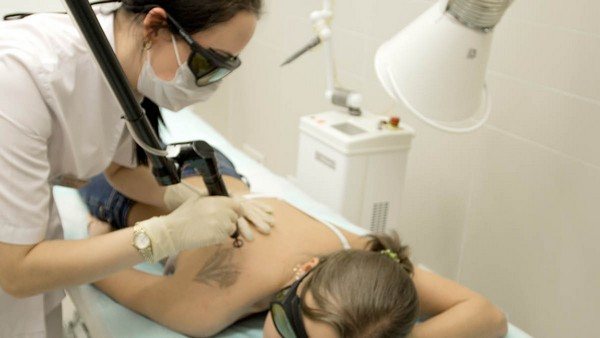

It is better to go to a clinic with a sufficient number of positive reviews about this procedure.
Myth 2: With laser it is possible to quickly and simply get rid of an annoying design
Laser is not an eraser and it is not supposed to remove a tattoo quickly. There are patients who had a full cycle of sessions to remove unwanted drawings on the body for more than a year or even two with sessions every 2-3 months. Such procedure is incomparable with simpler manipulations, such as unwanted hair removal. When using a laser, pigment particles in the skin are eliminated with their subsequent removal by the immune system.
Note! After the session, a long and difficult process of regeneration and recovery is required, accompanied by bleeding, pain and swelling.
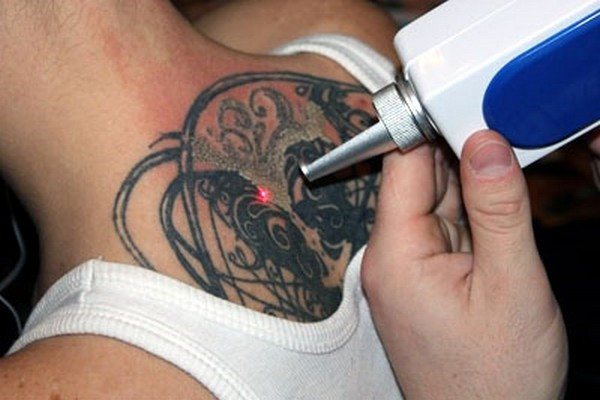

Fast removal of a tattoo by laser will not work, especially if it is of impressive size.
Myth 3. it is a painless process
The absence of pain and discomfort can only be if local anesthesia methods are used. In this case, if the size of the tattoo is large, it takes a lot of time. Only a doctor can perform an injection of lidocaine or other active anesthetic, and if the procedure is carried out by a person without medical training, then this method of anesthesia is not applied. Very unpleasant can also be the removal of small tattoos, because the pain depends not only on the size, but also on the color of the pigment. The only difference will be that when removing small tattoos, the process will take significantly less time.


Discomfort in the process may be felt if anesthesia has not been applied
Myth 4: To remove a tattoo by laser in any case is safe
Unfortunately, not everyone tolerates this procedure without loss. This can be quite a difficult process for patients with a darker shade of skin (this is due to the peculiarities of the laser itself, which can "target" not only the pigment in the tattoo, but also the melanin contained in the skin).
Pay attention! Therefore we can say that the darker the skin tone of the patient, the harder it is to use the laser in the procedure, the higher is the risk of unwanted pigmentation and burn lesions.


People with dark or swarthy skin will have a more difficult process of tattoo removal
Myth 5: Removing tattoos is very easy
Drawings on the skin can be completely different. For example, to get rid of the black pigment is easiest, more difficulties will arise with green and blue color, but to do something with yellow, purple or white shade is almost unreal. Different wavelengths of laser are involved, which treat their pigment colors. The complexity of the approach can be with
Ways to remove tattoos
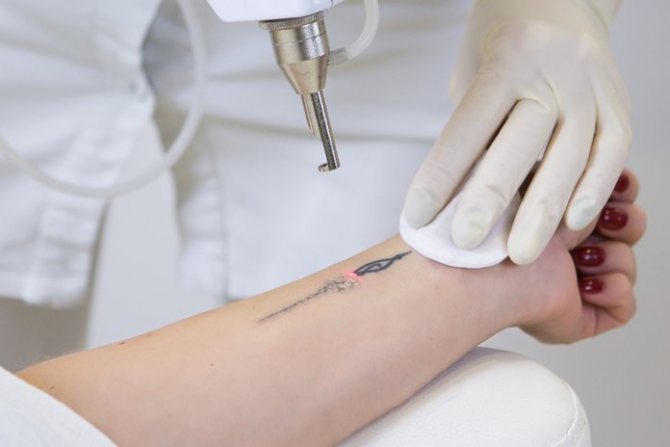

There are various methods of tattoo removal. The master chooses the most suitable option after consultation with the client. When choosing a method of removing the image, the depth, color and other nuances are taken into account. The cost depends on the method, size, number of sessions.
As a side note: If there is no need for complete removal of the tattoo, the number of sessions can be reduced. This is practiced when deciding to re-tattoo, that is, in place of the old image to make something new.
Laser is the best option


Photo: @sturova.laser
Removal of a black tattoo by laser will not cause problems. And to remove a drawing that has red, yellow, beige and white pigments will be more difficult. The laser is not good enough to see them. In this case it is necessary to pay attention to other methods of removal of a tattoo or to begin with the laser, and then "finish" with the remuver (about it read below).
How does the laser removal process work?


Photo: @vova_a4_
The laser beam affects the pigments, heating them, then they are crushed into tiny particles, and the lymph gradually removes them from the body. However, the laser beam affects only the top layer of paint, so a single session does not remove the tattoo completely, as the number of layers in each case is different (usually 3-8).
Source: @vova_a4_
It is believed that in one session, the tattoo lightens by 10-15%. But masters recommend waiting for the result not immediately, but after a couple of weeks. That is why the gap between visits to the specialist for removal is significant. You can not treat the skin with a laser every day, there will be a burn.
Surgical removal is an outdated method


Today, no one turns to a surgeon to remove a tattoo, as there are a lot of more advanced and less traumatic options. Some of these are laser and remuver. But previously it was possible to get rid of a small pattern up to 1 cm wide by surgery. To do this, the doctor cut off a thin layer of epidermis and applied cosmetic stitches.
Mechanical peeling
Dermabrasion - A method of scraping the skin with a special tool with a diamond coating.
This is a very traumatic option, so it is rarely used to remove tattoos. Usually mechanical peeling is used by cosmetologists and plastic surgeons to remove and correct skin defects - scars, scars.
Chemical peeling
One of the most aggressive procedures for removing the upper layers of the dermis is a chemical peel. This option is rarely used to remove tattoos, as it is considered painful, dangerous and undesirable. The essence of the technique is the gradual exfoliation of the staining pigment through the use of carbolic acid.
Remover - gently, but for a long time


Today is gaining popularity a method of removing tattoos and tattooing with remuvera. This procedure involves injecting a special suspension under the skin, which destroys the pigment from within. It is gradually eliminated, so the result is noticeable not immediately, but after 2-3 weeks. Repeated procedure is scheduled no earlier than one month later.
After removing tattoo remuverom can not within a day to wet the place of introduction of the drug, and then tear off the crusts formed.
Overlapping
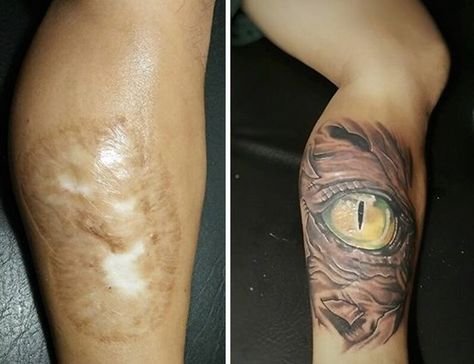

Overlaying the scar with a tattoo
If you're planning on replacing an old tattoo with a new, more modern and current one, it's not worth spending a lot of time and money to remove it 100%. It's enough to lighten it with a couple of laser or remover treatments, and then head to the master for a new one.
Such an option as overlapping the old tattoo with a beige color is not worth using. First, over time, the bottom layer will show up. Secondly, it is almost impossible to remove the beige pigment.
Folk methods
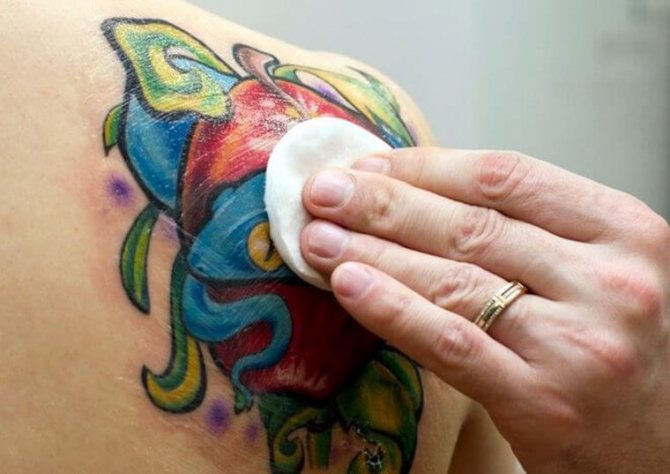

Remove the tattoo completely by folk methods impossible. But the use of salt, regular visits to the bath, manganese, iodine, hydrogen peroxide can noticeably damage the pattern, leaving a scar or burn on the skin. Therefore, it is not worth experimenting with folk recipes, and immediately contact a specialist who will laser lighten the hated image.
Consequences of intervention
Up to two days after the procedure to remove tattoos can be observed pain and discomfort - this is a normal reaction. You can alleviate the symptoms with a cold compress with ice. Also after the session, you may encounter slight swelling, changes in pigmentation and the occurrence of bleeding. The skin may become red. After about 1-2 days, the symptoms stop, and there is a crust on the place of the tattoo, which disappears in two weeks.
Pay attention! If you have had to deal with prolonged pain, severe redness or swelling that does not go down, it is necessary to contact the surgeon to prevent possible complications.
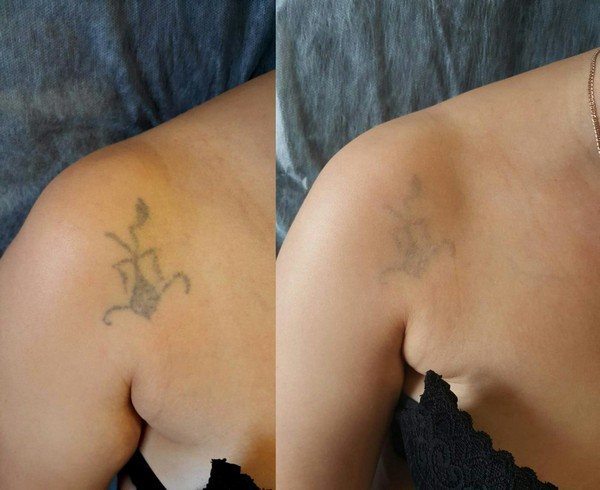

There may be some discomfort after the procedure.
Up to two months the process of removing the pigmentation may continue, the tattoo will gradually fade and disappear. The amount of time spent on this process depends on the individual characteristics of the body.
Home methods
Since tattoo removal - process is not only long, but also expensive, it was invented a lot of ways to get rid of the figure without visiting the salon. Home methods can remove a small part of the pigment, but completely get rid of it will not work. Consider the most popular methods.
Special creams
Various creams and ointments are most effective only against fresh tattoos. Such ointments are much cheaper than the salon procedure, but they are also ineffective: for the old pigment, embedded in the skin, such a tool is useless.
It is worth remembering that applying the cream on the newly applied tattoo increases the risk of infecting the damaged skin area.
Manganese solution
The well-known manganese is a potent oxidizer. Yes, it can remove unwanted patterns, but only together with the skin: manganese solution burns its upper layer together with the pattern.
The result is sloppy scars, crusts and long-lasting healing. In addition, scars and hyperpigmentation of the skin can form in the place of chemical burns.
5% iodine solution
Tattoo removal with iodine is not a quick process. According to Internet users, if you smear your image with iodine for a long time, it will gradually discolor.
Thus it is really possible to reduce the intensity of staining a little bit, but it will not be possible to remove the image completely. Iodine acts on the surface of the skin, while the color pigment penetrates the deeper layers of the dermis. If you inject the iodine solution directly under the skin, you will get a scar and a chemical burn instead of a pattern.
Bath, sauna, and hammam
The method of profuse sweating is popular with those who did the tattoo and immediately changed their minds. The logic here is simple: with a lot of fluid loss, some of the pigment will come out with the sweat, possibly for good. Needless to say, this is more like a myth?
Overheating the damaged skin will not lead to loss of color. The baths after the tattoo are forbidden, because the heat stimulates the flow of lymph and blood in the body. Because of this, a swelling is formed on the area with the tattoo, which may not subside for a long time.
Salt scrub
It is positioned as a remedy for the removal of a fresh drawing. Such a scrub will irritate the epidermis and is actually used to remove it. In doing so, the hypertonic solution will draw the liquid out of the skin with some of the pigment.
Disadvantages of salt scrub:
- Pain and the length of time it takes for the lesions to heal. Salt traumatizes the skin and interferes with the natural regenerative process. The scrubbed area will be red and swollen.
- A salt scrub will not get rid of the pattern completely. It will help to remove some of the pigment and disturb the pattern.
- Danger of infection. This is the main reason not to use salt scrub.
Scarring of the tissue. After removing part of the pattern, a large unsightly scar can remain in its place.
Number of procedures and duration of waiting for the result
Depending on the characteristics of the pigment and the size of the tattoo, you may need from two to twelve treatments, the results of which will be able to assess the result. Be sure to stay in touch with your doctor to let him know of any alarming changes in your condition. Don't hesitate to ask if there are any questions about your well-being.


Usually 2 to 12 treatments are required
What complications can I encounter?
In most cases the procedure is easy and without complications. If there are any risks in your individual case, your doctor will explain them at the first consultation.
The list of complications that can occur is:
- Hematomas, accumulation of fluids during the removal of pigment;
- infection;
- bleeding;
- problems with sensitivity in the treated area;
- scarring;
- allergy;
- the absence of the primary effect.


Complications are rare, but they are still possible
In addition, there is a possibility of encountering specific changes that are associated specifically with the reduction of the tattoo:
- problems with pigmentation in the treatment area;
- Changes in the structure of the skin;
- In rare cases - the darkening of the picture.
Pay attention! Risks can be minimized by strictly following the rules and advice given by the surgeon after the procedure.
Reviews
Marina, Vladimir
"I had my "mistake of youth" - a tattoo on the neck - removed with a neodymium laser. I can not say that it was much pain, but I felt discomfort. This is understandable - the skin on the neck is quite delicate. But the most important thing for me was to finally remove the tattoo, because it was really ruining my life. It took me 10 sessions because the tattoo itself was pretty big. But the beautician told me that the pigment was shallow, otherwise more sessions would have been needed. Gradually the tattoo became lighter and now it's gone. I'm very happy.


Patients confirm that laser removal of tattoos is really effective
Ivan, Moscow
"Got a tattoo a couple of years ago, and now I just stopped liking it. I decided to remove it, thanks to the fact that now it is possible to do it with a laser. I have a high pain threshold, I experienced no discomfort. We removed the tattoo in 8 sessions. My skin is clean now, no scars left. I like everything.
Types of Image Removal Devices
Laser tattoo removal can be performed using several types of equipment:
- Ruby. This device is most effective in the removal of small surfaces with an image in black, green and blue. The disadvantage of such a device is the low processing speed.
- Alexandrite. The equipment allows you to display the image when the dye pellets are located deep in the skin. Unlike the ruby laser, the alexandrite laser has a fairly high processing speed for skin that has been imprinted with black, green, and blue ink.
- Neodymium device. A versatile device that provides a high speed of drawing almost any color.
The neodymium laser, in turn, is divided into four types. It can be green, red, yellow and infrared. The last type allows you to remove dark images from the skin. At the same time, its saturation and complexity does not affect the efficiency and speed of withdrawal. The main advantage of the infrared laser is minimal alteration of the natural pigment of the skin.


The ruby device is most effective for the removal of small surfaces with black, green and blue images
Before and after photos
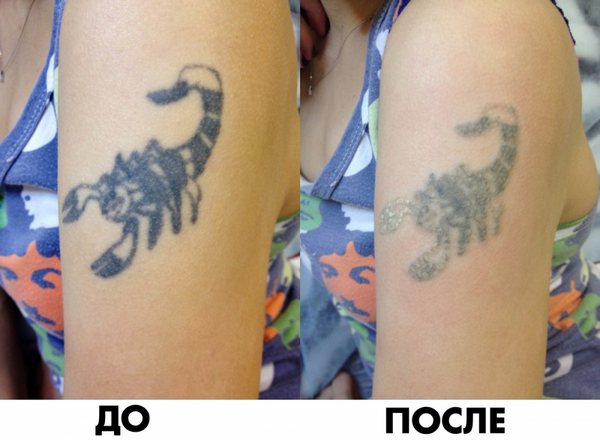

The photo before and after a course of procedures to remove tattoos with laser #1
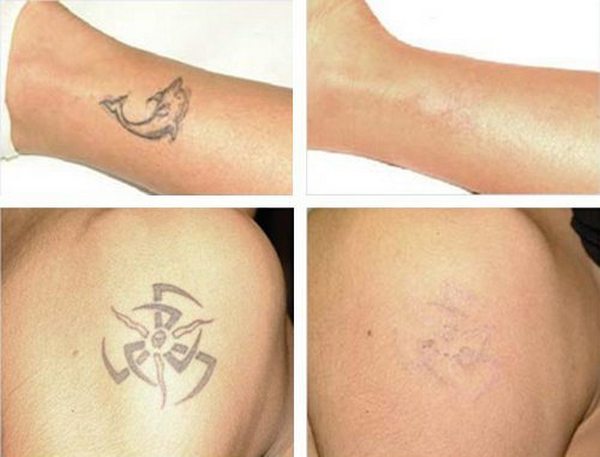

Photo before and after the course of procedures to remove tattoos with a laser number 2
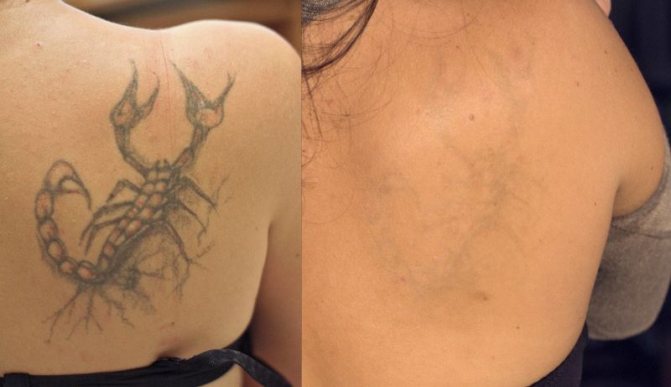

Photo before and after the course of procedures to remove tattoos by laser number 3

